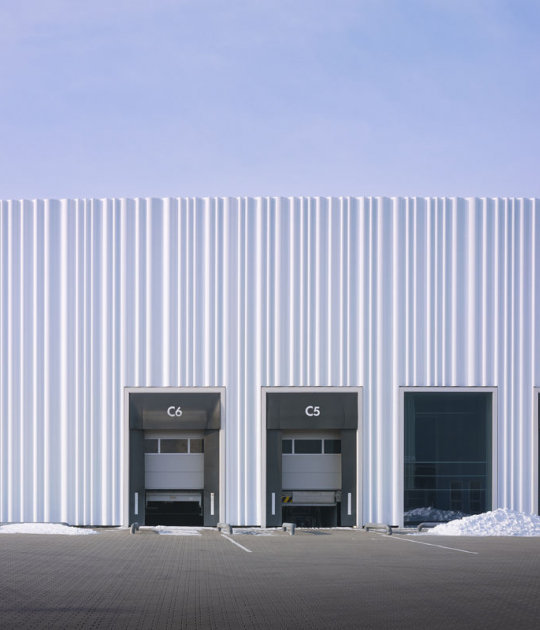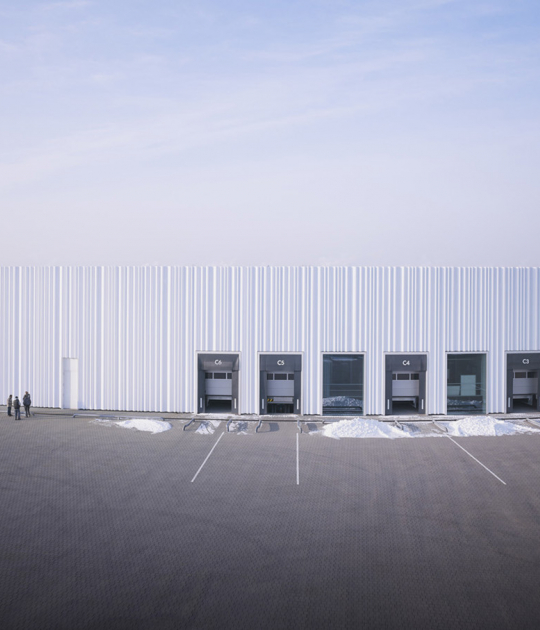Although “Diogene’s” façade matches that of a simple house, it is, in reality, a highly complex technical building with consumption, production and disposal satisfying the highest demands of sustainability and energy efficiency.
Be it as a secondary residence in nature, a home office in one's own garden or as a temporary installation, the object fulfils the dream of minimalist housing and offers a retreat for the modern-day Diogenes – an urban nomad who longs for the return to a simple lifestyle, far away from the bustle, noise and distractions of everyday life.
The development of Diogene
In an interview with Renzo Piano, the architect explains that the ideal of minimalist housing is something which he has been considering since his student days. It is a kind of obsession, but a good one. A living space of two by two by two metres – just enough space for a bed, a chair and a small table – is a dream many architecture students share. Back then, he was unable to realise the idea. At the end of the 1960s, however, when Piano was teaching at the Architectural Association in London, he joined forces with his students to build mini houses on Bedford Square. The architect has also designed boats, cars and, a few years ago, cells for the nuns of the Poor Clare nunnery of Ronchamp. There too, it was about minimising the spatial environment of these people, not for reasons of economic efficiency, but for self-moderation. The minimalist house is an idea that continues to fascinate Piano, particularly in an era in which his office is dealing with big projects, for instance what was Europe’s tallest high-rise at the time of its completion in 2012 – “The Shard” in London.
About ten years ago, of his own volition and without a specific client, Renzo Piano began developing a minimalist house. Various prototypes were developed in Genoa – from plywood, concrete and, finally, from wood. The final version of the project which Piano dubbed “Diogene” was published in autumn 2009 in the monograph booklet “Being Renzo Piano” by the Italian magazine “Abitare”: a wooden saddle-roofed house with a 2.4 x 2.4-metre surface area, a ridge height of 2.3 metres and a weight of 1.2 tonnes. Piano presented his vision to the public in the magazine, but noted in a comment that he needed a client in order to continue developing “Diogene”. The Italian architect found his partner in Rolf Fehlbaum, chairman of the Vitra AG. Fehlbaum had read the issue of “Abitare” and immediately felt attracted to Renzo Piano’s ideas, as Vitra does not regard itself as a manufacturer of individual design objects, but defines furniture as an essential part of the human environment. If we look back at the history of furniture design, it was always about requalifying people’s living space; the living landscapes of the 1960s and 1970s are just one case in point.
At the end of June 2010, there was a meeting between Renzo Piano and Rolf Fehlbaum, who at that time were still members of the Pritzker Prize jury. During this meeting, they agreed to continue the “Diogene” project together. After three years of development work, a new “Diogene” prototype is being presented at the Vitra Campus on the lawn opposite the VitraHaus on the occasion of the Art Basel 2013. It is not a finished project, but an experimental arrangement enabling Vitra to test the potential of the minimalist house. Vitra is thus breaking new ground: While usually only products which are ready for series production are presented to the public, it was decided to let the public take part in the testing of “Diogene” due to the complexity of Renzo Piano’s project. The further development of the project and whether it will go into series production will be decided on at a later date.

Diogene by Renzo Piano, 2013. Photography © Julien Lanoo. © Vitra.
The idea of the minimalist house
The simple, archaic house situated in nature, which – based on the antique concepts of theoretical architect Vitruv – marks the beginning of technology and architecture, aroused renewed interest at the end of the 18th century, as is particularly evident from the copperplate engraving of the original Vitruv hut, which was included in the 1755 2nd edition of Marc-Antoine Laugier’s “Essai sur l’Architecture”. Since then, the idea of the minimalist house has repeatedly fascinated architects. Sometimes the focus was placed on the formal aspects, and sometimes on social considerations, such as the “subsistence level apartment”, which was a topic of discussion in the 1920s and 1930s. In the 1960s, which were defined by structuralism, the minimalist cells were combined into clusters. In the recent past, the discussion revolved around mobile living structures for use in natural catastrophes or in war-torn areas of the world.
Diogene is not an emergency accommodation, but a voluntary place of retreat. It is supposed to function in various climate conditions, independent of the existing infrastructure, i.e. as a self-sufficient system. The required water is collected by the house itself, cleaned and reused. The house supplies its own power and the necessary platform is minimised. We live in an age in which the demand for sustainability forces us to minimise our ecological footprint. This postulate is paired with the desire to concentrate and reduce the direct living environment to the truly essential things. Diogene might remind one of Henry D. Thoreau, who wrote the following in his book “Walden/Life in the Woods” in 1854: “I went to the woods because I wished to live deliberately, to front only the essential facts of life, and see if I could not learn what it had to teach.” It is no coincidence that Piano also regards his project as “quite romantic” and emphasises the aspect of “spiritual silence” which it conveys: “Diogene provides you with what you really need and no more.”
As architectural references, Renzo Piano lists the “Cabanon”, which Le Corbusier constructed at the beginning of the 1950s in Cap-Martin in the Côte d’Azur, the prefabricated house structures of Charlotte Perriand, and the Nakagin Capsule Tower, which Kisho Kurokawa erected in Tokyo in 1972. The late 1960s and early 1970s in London were very formative years for Piano: In the interview, he mentions one particularly important influence during this era as being Cedric Price with his “Fun Palace” and the hippie movement.
Diogene and its equipment
Diogene, named after the antique philosopher Diogenes who is said to have lived in a barrel because he considered worldly luxuries to be superfluous, is a minimalist living unit which functions completely autonomously as a self-contained system and is thus independent of its environment. With a surface area of 2.5 x 3 metres when fully assembled and furnished, it can be loaded onto a lorry and transported anywhere. Whereas “Diogene’s” exterior corresponds to the image of a simple house, it is in truth a highly complex technical structure, equipped with various installations and technical systems that are necessary to guarantee its self-sufficiency and independence from the local infrastructure: Photovoltaic cells and solar modules, a rainwater tank, a biological toilet, natural ventilation, triple glazing. To optimise the house’s energy, Renzo Piano is working with Matthias Schuler from the renowned company Transsolar, while Maurizio Milan is responsible for static equilibrium.
Diogene is equipped with everything you need for living. The front part serves as a living room: On one side, there is a pull-out sofa; on the other, a folding table under the window. Behind a partition, there are a shower and toilet as well as a kitchen, which has also been reduced to the necessary. The house and furnishings form a single unit. It is constructed from wood with a warm character, which also defines the interior. For the purpose of weather protection, the exterior is coated with aluminium paneling. The overall shape and saddle roof resemble the archetype of a house, but its rounded-off corners and the all-over façade materials also give the impression of a contemporary product. It is no simple hut, but instead a technically perfect and aesthetically attractive refuge. The great challenge lies in planning the complex product so that it is suitable for industrial series production. “This little house is the final result of a long, long journey partially driven by desires and dreams, but also by technicality and a scientific approach,” explains Renzo Piano.
Diogene has many possible uses: It can serve as a little weekend house, as a “studiolo”, as a small office. It can be placed freely in nature, but also right next to one’s workplace, or even as a simplified version in the middle of an open space office. However, it is also conceivable to erect groups of houses, e.g. as an informal hotel or guest house. Diogene is so small that it functions as the ideal retreat but purposely does not cater for all needs to the same extent. Communication, for instance, will take place elsewhere – and thus Diogene also invites you to redefine the relationship between the individual and society.
Txt.- Hubertus Adam
Availability
Depending on the desired purpose and individual resident needs, the living unit will be available from Vitra as of 2014 in three different versions. For further information, please contact the VitraHaus sales team (sales.vitrahaus@vitra.com, +49 (0)7621 702 3502).
Tour
From Wednesday, 12 to Sunday, 16 June (Art Basel week), the “Diogene” prototype on the hill opposite the VitraHaus can be viewed from the outside together with accompanying project documentation in the Dome without booking a guided tour.
































